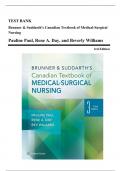Exam (elaborations)
Test Bank - Brunner and Suddarths Canadian Textbook of Medical-Surgical Nursing, 3rd Edition (Paul, 2016), Chapter 1-73 | All Chapters
- Course
- Institution
- Book
Test Bank - Brunner and Suddarth's Canadian Textbook of Medical-Surgical Nursing, 3rd Edition (Paul, 2016), Chapter 1-73 | All Chapters
[Show more]



